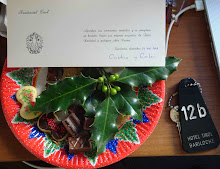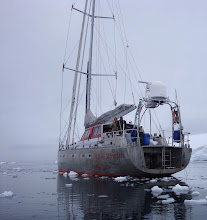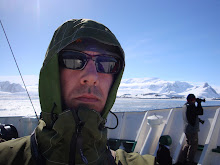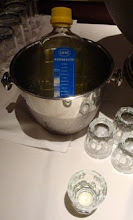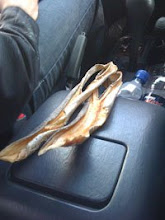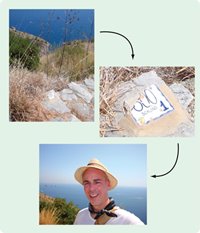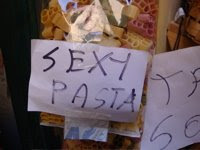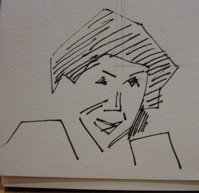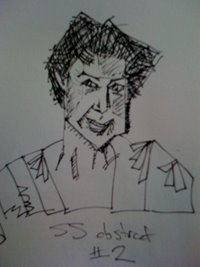Wednesday, September 24, 2008
Tuesday, September 23, 2008
Friday, September 19, 2008
Thursday, September 18, 2008
Wednesday, September 17, 2008
Tuesday, September 16, 2008
Monday, September 15, 2008
Sunday, September 14, 2008
101 Reykjavík
I left the Anderson Clan alone for the day, with the goal of figuring out what to do with rest of my stay in Iceland. I easily fell into the small town dynamic of Reykjavík, starting with the staff at the Holt. I asked who I should talk to about arranging my week. It seems everyone has a cousin, just down the street, who can help. One thing led to another, and by mid-day, I had arranged to rent a car, booked a hotel in the southeastern area near Skaftafells and Vatnajökull, arranged a glacier-walk tour, and booked car ferry passage to the Vestmannaeyjar Islands.
Then, I was on my own, walking the streets of Reykjavík, baking in the uncharacteristically bright sunshine. The Icelanders seemed very happy to be in shirtsleeves and sunglasses in the >20C warmth, though I, having been sun-blasted in the Mediterranean for weeks, had been looking forward to cooler weather and a break from smearing SPF30 on my head all day.
On yet another recommendation I ate a late jet-laggy outdoor lunch at the café Vegemot, in the central zone referred to a 101 Reykjavík**. I don’t know why this restaurant has that name. Veggies don’t seem to be a big part of the scene. I admired the young Icelandic women, sunbathing while they had drinks or caffe in the outdoor patio. Some Icelandic women are spectacular – they have a certain blockiness to their features that is exotic and characteristic. I first noticed this look with Maga and her family. There are a surprising (to me) number of red-haired people here, among the blonde and fair-haired. Upscale baby strollers are a big part of the daytime scene here as well (I forgot to pack mine), and the children of Reykjavík are well-behaved and often left alone by their parents, who seemingly don’t worry or hover over their kids as Americans often do. Part of island life, I suppose.
Reykjavík has a small town feeling and is a chic, sleek urban playground at the same time. I suppose it’s a kind of Carmel-by-the-Sea. But I don’t feel the ticky-tackiness that I always feel in places like Carmel. Probably just because I don’t speak the language. If I spoke Icelandic, I suppose I’d see through the shiny, sophisticated candy coating to the sweet, tourist-trap, milk-chocolate center... Hang on a minute – I think I just made myself hungry for a bag of M&Ms.
OK, I’m back.
The center of Reykjavík is pretty small, and I found myself walking up and down the main street. There are a lot of chic shops and cafes, and further up the northwest direction, a collection of Euro-designers (Maxmara, Prada, etc.) that bored me. But the Icelandic jewelry shops and some of the more esoteric women’s clothing shops were really interesting. I bought some pearls for a certain somebody, and a crazy sweater for myself.
This mellow day by myself ended with a Clan Anderson dinner. Ian sent me a last minute SMS to join them at an Italian restaurant on the main street. A relaxing meal, at which we also made plans to go experience the famous “Blue Lagoon” spa the following day. That seals my Anderson adoption papers, I think to myself as walk around town again afterwards, before turning in early at my cozy, woody room at the Hotel Holt.
**I haven’t seen this movie yet, but it’s on my Netflix list. Or it would be, if I had a Netflix subscription. Or a TV.
Thursday, September 11, 2008
Aqualung, my friends
The Holt is an old, slightly decadent hotel just enough outside the center of Reykjavík to be quiet, but close enough that the city center is minutes away. Wood everywhere, and dark. It’s old, but everything in the hotel functions flawlessly. Doorknobs turn soundlessly. My room, which is next to the elevator, was quieter than a Roman crypt, day and night. (OK, the only crypt I saw in Rome was filled with loud drunk men – see “the United Nations of Bader”)
After a short but solid sleep, I dressed and went to breakfast. The dining room is paneled richly with dark wood, and the walls are filled with the art of well-known Icelandic painters from throughout the 20th century, most famously Kjarval. The breakfast buffet was fantastic. A nice mix of breakfast foods appealing to Americans/Brits (fruit, toast, cakes, coffee, just, cereal, sausages), some Euro-standard breakfasting (rich sour yogurt, muesli, cold cuts, cheese plate, chocolate biscuits), and some Icelando-Scandanavian treats (pickled fish, egg custard, shot glasses of chilled cod liver oil [!!]).
At breakfast, I chatted briefly with a friendly Britisher family at the table next to mine. A nice contrast with other “B&B” experiences in which people sitting at adjacent tables in Italy and Israel maintained a monastic silence during breakfast.
Full, happy, I headed to the front desk to seek help with planning my week in Iceland. While I was talking to the staff, a member of the family I breakfasted next to came up and interrupted us to invite me to join their private family tour of the area. Of course, I jumped at this, running upstairs and grabbing my gear for a day out in the countryside.
Trundling into one of the two SUVs being piloted for a drive around the “Golden Triangle” area near Reykjavík, I got introduced to everyone, and slowly took in their names. Maga, Daniel, Ian, Shona, Gael, James, Andy, Tilde. As we drove on and got to know each other, I slowly realized who I was with. Maga and Daniel are a young Icelandic couple, and our guides for the day. The rest of the crew are a family, surname Anderson. The Andersons are in the music business, and they do a lot of recording, performing and road shows. What kind of music, exactly? Aha. That Ian Anderson. I never know who famous people are. Maybe that’s why they invited me along?
We were headed for Thingvellir**, a national park. A vivid realization of the mid-Atlantic rift, in which you can see the newly formed land faulted and dropped abruptly as the tectonic plates inch apart. On the way, Ian wanted to stop by a little roadside landmark and look for a tree. There are hardly any trees on the island, having long since been burned for fuel, land-clearing, and charcoal creation. But this is a small grove, a “friendship” grove, in which noted people from other lands are invited by the Icelandic government to come plant a tree in friendship. Several years back, Ian had been invited and came out to a planting and dedication ceremony in a driving, horizontal snowstorm. Today, the sun was shining. Sunscreen weather. We were in shirtsleeves, and I wore the same hat that I needed to protect my alopeciatic skull in August’s sunblasted Rome and Jerusalem heat. Ian couldn’t find the tree, but we admired the plaque that explained it all, and mentioned Queen Elizabeth II and her planting. I can find no trace of this landmark on the web. It’s kind of nice to think that some things are not immediately Google-able. Except now that I’m writing this, I’ve just changed that !
Thingvellir contains the original democratic house of Iceland, the Althing, which is many hundreds of years old. Didn’t go there. But we did go see the geyser that gave geysers the name “geyser”. It’s called “Geysir”. Well, the one that actually still spouts is called Strokkyr, which sounds like an 80’s metal band. It’s great to stand next to these geysers, because there is no one to tell you how close to get, and there are no warnings as would be ubiquitous at something like a geyser in the US of A.
We rolled onto the very impressive nearby Gullfoss waterfall. It’s a tremendous waterfall, made even more wonderful by how approachable it is. You can stand on a bit of green-covered rock above the most violent convergence of the falls. As I did. One step back and you’re in the glacier runoff soup. I heard that people die here regularly, but I don’t believe it. There just aren’t enough visitors that come here to have many deaths. At this point, I deviated from my life-long avoidance of photography and started snapping random and poor pix.
Most interesting of all was the visit we made to Maga’s family’s farmhouse just down the road. I’m not sure exactly what relations they were (parents? grandparents? uncle/aunt?). They really live on a farm. There are many farmers in Iceland, and in fact, sheep ranching appears to be the main thing to do for a living outside Reykjavik. Maga’s relatives were very gracious with the horde that piled into their honey-colored wood cabin style home. They built it (I think!) themselves, and it’s across the road from their horse stables and part of the farm. As you look to what I think is the south, you see the expanse of the plains of Thingvellir. Maga’s relatives had prepared a spread for us – a kind of late afternoon tea. Everything they served us to eat, they had made themselves. My favorite was the smoked lamb. Smoked lamb? We also had homemade butter, and home-dried haddock (or was it cod?), steam bread, and I don’t know what else. It was a kind of tea, so everyone ate lightly, but I found myself wanting to clean all the plates. At 46 years, though, I’ve learned to restrain myself. Kinda.
It was a wonderful mix: the Icelandic farmer family, the world-hopping Anderson/Jethro Tull musician family, and a random American, thrown in like a bay leaf into a stew.
After tea, we walked across the road to the stable, and Maga and her (mom? aunt? grandmother?) rode impossibly idyllic-looking Icelandic horses. Icelandic horses are something else. They have a strange, slanted look to their eyes that makes them look sly. And they are small. But they are very pretty and spirited. They are very different from our big, broad horses. I guess they’re island-sized? I couldn’t really believe I was there on the Thingvellir plain, watching these beautiful Icelandic women trot horses around the corral, luck bringing me into this traveling family and their Icelandic friend’s farmhouse, with a double rainbow emerging to the south…
We retired to the Holt, and I talked some of the crowd into a drink in the 70’s style library/den/bar off the lobby of the Holt. Andy and James talked me into eating pizza and drinking a bottle of wine in James’ suite afterwards. “Spelt” pizza? None of us knew what that was, but we ordered it anyway, and ate it on the carpeted floor of their suite. Andy re-taught me backgammon (why can’t I remember the rules?) and beat me over and over. I vow to defeat him one day. A jokey, fun time. Good men. Gael joined us at the end, after little Tilde went to sleep in Andy & Gael’s suite.
Only the next day did I learn that Andy is a famous screen actor. Once again, I failed to recognize a famous somebody. I didn’t care. This is the experience I was hoping to have on this trip.
** In Icelandic, this name actually starts with a letter that looks like “P” with a slash through it. Microsoft does not have any international font/character corresponding to this character, but it most closely sounds like a “th”.
Business Class turns out to be nicer than Economy
Jerusalem to Tel Aviv, by bus
then 4 flights…
...Tel Aviv/Ben Gurion -> Paris/CDG
...Paris/CDG -> Munich
...Munich -> Cologne/Bonn
...Cologne/Bonn -> Keflavík
finally…
Keflavík to Reykjavík by bus
At Ben Gurion, you get your luggage examined and you get questioned before you even get your boarding pass. The questions make you nervous! Every other airport I’ve been to, the questions are so throw-away, pro-forma. Here, you get a line of questioning, and they will react to what you say and chase down details.
Business class flights for the first half of the journey. In my ~250,000 miles of air travel, I’ve flown business class before. But I’ve never been in a business class airport lounge. It is so relaxing. I ended up having wine at 11AM, and by the time I got to Munich’s international airport, I was full and a little tipsy, feeling relaxed.
With a long layover to the economy class half of the trip, I wandered the airport, drawn to the big fabric-covered central “platz”. This architecture makes so much sense at an airport. The terminal buildings on all sides communicate with a huge open square that is protected from the elements with a giant, aesthetically-pleasing fabric structure. Outside air and light move through the space. The edges of the platz contain restaurants, shops and biergartens. The center acts as a pedestrian thoroughfare and meeting place. The shape and structure of the place is such that there is a dusk-like light, even in the middle of the day, and the platz echoes with the footsteps of a thousand people. The effect is pleasant, but mildly disorienting and ghostly, making a spacey traveler spacier.
In the 2nd half of the air travel day, I registered a sharp contrast: economy class on Germanwings. On GW, you have to pay for, and separately register, each piece of luggage. And, you can’t check them through - you have to do the whole thing over again for your connecting flights. I’ve long since learned to carry food onto low cost airline planes, but was surprised to learn that on the 4 hour flight to Reykjavík, the only water available cost 3EU. Ouch.
No matter. Fortified by my earlier Business Class pampering, I spilled out onto the Keflavík airport tarmac with the other travelers in good spirits, though it was 1AM. Rain spritzed us on the long bus ride to Reykjavík, and I looked forward to what I was anticipating as the best leg of my journey.
Wednesday, September 10, 2008
Shabbat
Shabbat itself in the center of the New City: the streets emptied, and the shops and restaurants shuttered. Only a few tourist places stayed open as dusk and early evening fell. I had an early dinner at my reliable retreat directly across from the Harmony: the Zuni Café. A coincidence – they never heard of SF’s Zuni Café. They did tell me that they named the restaurant after Indian tribe from the New England area of America. Oh well. Close enough.
After a short sleep: mayhem at 3AM. Thousands of young drunk people in the streets. But the windows at the Harmony are good! You could barely hear them, though when I opened the windows, it sounded like a rock concert outside my hotel. Such a contrast with the silence of the early evening before.
Waiting for the shuttle phone call in the lobby, I was actually a little worried. I could hear glass bottles breaking and not-so-friendly drunken shouts once the so-friendly, middle-of-the-night Harmony staffer David opened the windows. In idle chatter with David, he learned I was going to Iceland next. He got so excited talking to me about it, I think I almost missed my shuttle. We exchanged contact information, and he promised to send me information about Iceland, a place he always wanted to visit. In the last minutes of my stay in Israel, I had made a connection with someone.
Isra
It was a pretty good massage. A bit more “IDF” and a bit less “namaste” than I am used to. I ended up with a couple of bruises, actually, which I’ve never experienced after a massage before.
After the hour was up, Isra did this quick swipey-thing to my head with both hands and announced it was finished. I sat up, and he said, “OK, so nothing special?” I didn’t say anything and the moment passed.
I guess I’ll never know if there was a language miscue, if some cultural difference existed, or if the Harmony had arranged a different kind massage than the one I had in mind…
Yad Vashem
It’s the first museum I’ve been to were people are openly crying, and I found myself shaken and at the edge of tears myself a couple of times. The numerous video-taped recollections of survivors of the death camps and the mass murder sites are so gripping that you can’t believe the people telling the tales (all children at the time) were able to speak about it. Details like how women at one camp were led to the edges of the pits in groups of 10, ordered to disrobe and pile their clothing in a certain place, how they would stand and what direction they would face… And that there were people who survived all that and could describe everything that happened while people were killed by the thousands. Survivors of such a thing must have held two ideas in tension through the rest of their lives: (1) no merciful god would allow such a thing; and (2) divine miracles absolutely must exist.
I’ve never seen the actual workings of the killing pits and the concentration camps described in detail before. The sculpted scale models at Yad Vashem show particular camps with architectural style details and are filled with people actually moving through the gas chambers that show what happened to them during and after they were killed. These are still stuck in my mind.
David Olère, a survivor who had somehow made many works of art while working in a death camp (and afterwards, too.). His original drawing, "David Olère Burying the Remains of Children" was a particularly gruesome and arresting image. I felt compelled to make a sketch of it while standing in front of it.
Tuesday, September 9, 2008
King David
The night I decided to make this change, I was walking to a part of Jerusalem called the “German Colony” for dinner based on vague recommendations from the Harmony Hotel. I’d stop at big intersections and stand around for a few minutes. Maybe ask directions.
At one intersection, I was standing idly when an old man with a dog approached me. He asked me in English where I was going. I told him that I was looking for King David (that’s the name of a large road here.) He replied with a smile, “You’ll need an airplane and a time machine.” It took me a few seconds to understand the joke. He was referring to the actual King David, a joke made easy by the fact that I didn’t say “King David Road.” I laughed, and we struck up a conversation. At one point, we exchanged names (I forget his unpronounceable name), and he shook my right hand with his cupped left hand. This happened to me a couple of other times in Israel, but I could find no explanation of it. I know some cultures don’t like to use right hands for greetings or eating, but that doesn’t seem to be what is happening here…
Anyway.
Our conversation shifted and the gentleman began animatedly telling me how great Israel’s business and tech sector is doing. When he asked me why I came to Israel, I told him it was technology work, and that I was an engineer and scientist. In the mid-sentence, he quickly reached over and slapped me lightly on the forehead. “I knew you had a science brain!” he said, or close to it.
You could have knocked me over with a feather at that moment.
Monday, September 8, 2008
Old City
Most of the tourists walking through the Old City are in large groups. Like pilgrims. Some groups are even singing Christian hymns as they walk down past the Stations of the Cross on the Via Dolorosa. The Arabs and Muslims hawk them religious souvenirs outside the souks, and cheap goods inside the souks.
Many of the people living in the Old City are Orthodox Jews. To my eyes, unaccustomed to seeing so many of them, they seemed strange indeed. But in my ignorance, I grew to appreciate the galaxy of Orthodox gear and fashion. All the slightly different outsized hats, the earlocks from small and elaborate, the bits of string that I guess signify good works (I am indeed ignorant here…) It took me a while to realize it, but one thing that really got to me was that Orthodox Jews won’t look at me, or other non Ortho-folk. Especially the men. The woman and children would sometimes look at you, but only out of the corner of their eye, and when they thought you weren’t looking. (I break here to apologize in advance to any Orthodox Jews reading this out there that I might someday befriend, hire, or have sex with.) I’m afraid I really judged this behavior harshly, and perhaps unfairly. But, I wanted to challenge this. So for a few minutes I conducted an experiment** with random Orthodox men. I began aiming myself at them while we were walking past each other on the street, arranging near collision courses with them while looking into their faces. I was only bold enough to finally get to a shoulder bump with a couple. But none of them ever looked at me…
At the end of my hard day in the Old City, I took the recommended walk on top of the city walls – the “Ramparts Walk.” Looking into the ancient quarters, it occurred to me that while the passions of religion and violence of Rome are safely in the past, but the people of Israel and especially in the Old City of Jerusalem are still living them, are still living their divisions, still defining themselves in a way to separate from others. A truth that made me feel uncomfortable, because it meant that my enjoyment of a place like Rome was truly that of a tourist, a traveling dilettante.
But I also realized that if I came on this trip in part to try and connect with people, this isn’t the place I will be able to do it. Between the intense religiosity of the place and the tension between the different peoples, the emotional climate is too chilly in this hot and dusty place.
I resolved to quit the Old City of Jerusalem after this one day, and try the New.
**this experiment was inspired by a non-fiction essay I read earlier this year about a Western traveler’s trip to sub-Saharan Africa
Thursday, September 4, 2008
Harmony
I can recommend this hotel, and I was glad I sprang for fairly nice accommodations, as my days in Jerusalem would prove to be trying at times…
I enjoyed hanging out in the breakfast/dining/lobby area, which was one large room. I lingered almost everyday after breakfast, and came to the 5-7PM cocktail hour, though they were light on the actual cocktail experience. The Harmony concept of cocktail hour seems to be to plunk down a bottle of cheap vodka next to a bottle of cheap wine.
The public areas of the hotel are all outfitted with flat screen TVs that continuously play a 15 minute video loop of some kind of High Concept art. Typical scenes from the endlessly repeated loop: (1) two guys playing chess with life size chess pieces, where the pieces were made from differently colored (flavored?) ices. The ice lolly chess pieces melted in time-lapse videography as the game went on. The chess clock was a man inside a rotatable plexiglass hourglass-shaped box partially filled with ping-pong balls (2) a woman in high fashion clothing who climbs to the top of a canyon wall and silently screams into the abyss.
They may be trying a trying a bit too hard here at the Harmony Hotel.
Wednesday, September 3, 2008
Guns and no roses
Deciding to travel to Jerusalem by bus, I spent a fair amount of time wandering through the confusing central bus station. Israeli Defense Force members with automatic weapons slung over their shoulders were everywhere. The casualness with which they handle their big guns is unnerving. My bus ended up with one IDF member and a big gun.
More surprising is the number of young men not in uniform carrying sidearms or automatic weapons. This is the most unnerving thing, because you don’t know who they are and why they have guns. None of the (many) young IDF women that I saw carried any weapons.
It’s routine in Israel to be wanded, TSA-style, and to have your bag searched in any establishment. Restaurants and bars in particular always have someone with a wand you must submit to. Israelis apparently don’t think twice about this.
On buses, military police board and ask people to show their IDs. They don’t ask at random. If you look or dressed Arab, you get asked. If not, you don’t. I didn’t get asked. In fact, more than one person told me I look Israeli, and in contrast to my time in Italy, almost every Israeli stranger I had any encounter with assumed I understood Hebrew.
L'Chaim!
Tuesday, September 2, 2008
The little Israeli laser company that could
I got up at the Sheraton for my consulting day here in Tel Aviv early. It’s hard enough doing business travel, but when you wake up in a country you’ve never been in before, it’s best to give yourself a lot of time. This turned out to be wise, because even though it’s a Sheraton business type hotel, if you want to iron your shirt, as I did, you have to go to the common room for ironing. In a small featureless room that contained only irons and ironing boards, myself and one other shirtless guy stood ironing our shirts. The door to the room was open, and guests walking to the 2nd floor elevator looked at us ironing topless as they passed by.
I can’t really tell you much about the Israeli company I’m visiting here, because I’m bound to confidentiality. But I can tell you that it was quite an experience to visit this little laser manufacturer. They are scrappy. They managed to fit a multimillion dollar per annum operation in a single floor of an old office building. I don’t think the floor area is much bigger than the little house I just bought in San Francisco. It looks like I will probably continue doing some light duty work for them, though it seems unlikely that I will need to return to Tel Aviv to do it.
As we walked around the building, large fans blew air around in every room. Over the weekend, an antiquated water heater had failed on the floor just above and flooded the place. Even as they dried out and made piles of ruined materials, the company kept manufacturing and operations going.
My corporate host - I’ll call him “E” - is something of a foodie. He took me to a great sushi place, and a wine-oriented restaurant called the Coffee Bar. Upwardly-mobile Tel Avivans like E want to be thought of as world citizens, it seems. I got the sense from him and the city itself that people in Tel Aviv would like to distance themselves from the I/P conflict, and move on with there lives, their businesses. In Tel Aviv, I saw almost no Arabs or Palestinians, so this attitude is easy to affect.
At the Coffee Bar, we had Israeli wine (from the Golan Heights area, and it was very good). E is a wine buff, and shared lots of details of Israeli wind production. Like why Israeli wines historically have been both mostly kosher and not good, and the growing trend of non-kosher botique style Israeli wines. The particulars of how to make kosher wine. When I asked my host if these wineries or other new business went to similar trouble to make halal products (a question I later realized was kind of senseless, since alcohol isn’t favored in Islam), my host drew a blank. Living in a sea of 50 million Muslims, this gracious and welcoming world citizen had never heard of the Muslim equivalent of kosher.
Monday, September 1, 2008
"When Israel was in Egypt's land, let my people go..."
In our stilted English conversation on the drive to my hotel in Tel Aviv, she let me know early on that her father had been killed a few years back by a Palestinian suicide bomber. It seemed improbable that the first person I met in Israel would be affected in this way. After all, there are millions of Israelis, but only a few dozen are killed in this way each year on average. But, OK. Maybe so.
She pointed, seemingly at random, to a large building along the highway. “That’s my house.” It was a 3-story big building, maybe 400 square meters in floor space. Very large house for a midnight shuttle driver.
“I shook Barack Obama’s hand when he came to Israel.” That seemed especially improbable. In trying to hold up my end of the conversation, I asked her about Obama’s media moment in Israel when he famously went to the Kotel (the Western Wall) on his visit. “Obama did not go to Kotel.” I thought about the SF Chronicle article I read on his visit, the radio reports. Maybe we were just having a difficult time communicating.
Then Vered talked about her five children, how she had to work day and night to keep them in Playstations and Adidas. Then it was my turn. Did I want children someday? Not really, I replied. “I don’t believe you. I think you are lying.” she responded.
How about that - we’re here at the Tel Aviv Sheraton already! OK, thanks! Layla Tov! Good night!


